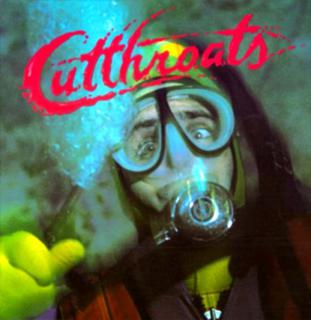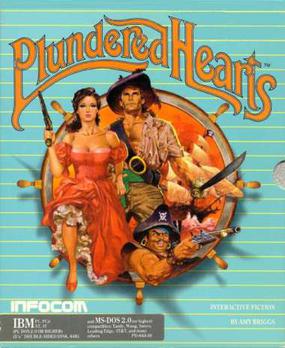Infocom was an American software company based in Cambridge, Massachusetts, that produced numerous works of interactive fiction. They also produced a business application, a relational database called Cornerstone.

Zork is a text adventure game first released in 1977 by developers Tim Anderson, Marc Blank, Bruce Daniels, and Dave Lebling for the PDP-10 mainframe computer. The original developers and others, as the company Infocom, expanded and split the game into three titles—Zork I: The Great Underground Empire, Zork II: The Wizard of Frobozz, and Zork III: The Dungeon Master—which were released commercially for a range of personal computers beginning in 1980. In Zork, the player explores the abandoned Great Underground Empire in search of treasure. The player moves between the game's hundreds of locations and interacts with objects by typing commands in natural language that the game interprets. The program acts as a narrator, describing the player's location and the results of the player's commands. It has been described as the most famous piece of interactive fiction.

Suspended: A Cryogenic Nightmare is an interactive fiction video game written by Michael Berlyn and published by Infocom in 1983. Infocom's sixth game, it was released for Amstrad CPC, Apple II, Atari 8-bit computers, Commodore 64, Commodore Plus/4, IBM PC compatibles, TRS-80, and TI-99/4A. It was later available for Mac, Amiga, and Atari ST.

Bureaucracy is an interactive fiction video game released by Infocom in 1987, scripted by comic science fiction author Douglas Adams. Infocom's twenty-fourth game, it is part of the Infocom Plus range which requires a machine with a minimum of 128K of memory.

Leather Goddesses of Phobos is an interactive fiction video game written by Steve Meretzky and published by Infocom in 1986. It was released for the Amiga, Amstrad CPC, Amstrad PCW, Apple II, Mac, Atari 8-bit computers, Atari ST, Commodore 64, TI-99/4A, and MS-DOS. The game was Infocom's first "sex farce", including selectable gender and "naughtiness"—the latter ranging from "tame" to "lewd". It was one of five top-selling Infocom titles to be re-released in Solid Gold versions. It was Infocom's twenty-first game.

Wishbringer: The Magick Stone of Dreams is an interactive fiction video game written by Brian Moriarty and published by Infocom in 1985. It was intended to be an easier game to solve than the typical Infocom release and provide a good introduction to interactive fiction for inexperienced players, and was well received.

The Lost Treasures of Infocom is a 1991 compilation of 20 previously-released interactive fiction games developed by Infocom. It was published by Activision for MS-DOS, Macintosh, Amiga, and Apple IIGS versions. It was later re-released on CD-ROM, and in 2012 on iOS.

Starcross is an interactive fiction game written by Dave Lebling and published in 1982 by Infocom. The game was released for the IBM PC, Apple II, Atari 8-bit computers, Commodore 64, TRS-80, TI-99/4A, and later the Atari ST and Amiga. It was Infocom's fifth game and first in the science fiction genre. Starcross takes place in the year 2186, when the player's character is a lone black hole miner exploring an asteroid belt. It sold 90,315 copies.
InvisiClues were hint booklets sold by Infocom to help players solve puzzles in their interactive fiction computer games.

Arthur: The Quest for Excalibur is an illustrated interactive fiction video game written by Bob Bates and published by Infocom in 1989. It was released for the Apple II, Amiga, Macintosh, and IBM PC compatibles. Atypically for an Infocom product, it shows illustrations of locations, characters and objects within the game. It is Infocom's thirty-fourth game and is the second of two Infocom games developed by Challenge using Infocom's development tools.

Sorcerer is an interactive fiction game written by Steve Meretzky and released by Infocom in 1984. It is the second game in the magic-themed "Enchanter trilogy", preceded by Enchanter and followed by Spellbreaker. It is Infocom's eleventh game.

Spellbreaker is an interactive fiction video game written by Dave Lebling and published by Infocom in 1985, the third and final game in the "Enchanter Trilogy." It was released for the Amiga, Amstrad CPC, Apple II, Atari 8-bit computers, Atari ST, Commodore 64, Classic Mac OS, and MS-DOS. Infocom's nineteenth game, Spellbreaker is rated "Expert" difficulty.

Deadline is an interactive fiction detective video game published by Infocom in 1982. Written by Marc Blank, it was Infocom's third game. It was released for the Amstrad CPC, Apple II, Atari 8-bit computers, Commodore 64, IBM PC, Osborne 1, TRS-80, and later for the Amiga and Atari ST.

Infidel is an interactive fiction video game published by Infocom in 1983. It was written and designed by Michael Berlyn and Patricia Fogleman, and was the first in the "Tales of Adventure" line. It was released for the Amstrad CPC, Apple II, Atari 8-bit computers, Commodore 64, IBM PC compatibles, TRS-80, and TI-99/4A. Ports were later published for Mac, Atari ST, and Amiga. Infidel is Infocom's tenth game.

The Witness is an interactive fiction video game published by Infocom in 1983. Like Infocom's earlier title Deadline, it is a murder mystery. The Witness was written in the ZIL language for the Z-machine, which allowed it to be released simultaneously on many systems. It is Infocom's seventh game.

Cutthroats is an interactive fiction game written by Michael Berlyn and Jerry Wolper and was published by Infocom in 1984. It was released for the Amiga, Apple II, Atari 8-bit computers, Atari ST, Commodore 64, MS-DOS, TRS-80, TI-99/4A, and Mac. It is Infocom's thirteenth game.

Moonmist is an interactive fiction game written by Stu Galley and Jim Lawrence and published by Infocom in 1986. The game was released simultaneously for the Amiga, Amstrad CPC, Apple II, Atari 8-bit computers, Atari ST, Commodore 64, MS-DOS, TRS-80, TI-99/4A, and Mac. It is Infocom's twenty-second game. Moonmist was re-released in Infocom's 1995 compilation The Mystery Collection, as well as the 1996 compilation Classic Text Adventure Masterpieces.

Border Zone is an interactive fiction video game written by Marc Blank and published by Infocom in 1987. It was released for DOS, Apple II, Commodore 64, Amiga, Atari ST, and Macintosh. Unlike most other purely text-based games, Border Zone incorporates real-time aspects of gameplay. It is also Infocom's thirtieth game. Its tagline is "Action and international intrigue behind the Iron Curtain."

Plundered Hearts is an interactive fiction video game created by Amy Briggs and published by Infocom in 1987. Infocom's only game in the romance genre, it was released simultaneously for the Commodore 64, Atari 8-bit computers, Atari ST, Amiga, classic Mac OS, and MS-DOS. It is Infocom's twenty-eighth game.

Journey: The Quest Begins is an interactive fiction computer game designed by Marc Blank, with illustrations by Donald Langosy, and released by Infocom in 1989. Like the majority of Infocom's works, it was released simultaneously for several popular computer platforms, such as the Commodore 64, Apple II, and PC. Journey is unusual among Infocom games in that it could be played entirely via mouse or joystick, with no typing required. It was the thirty-fifth and last game released by Infocom before parent company Activision closed the Cambridge office, effectively reducing Infocom to a "label" to be applied to later games.


















